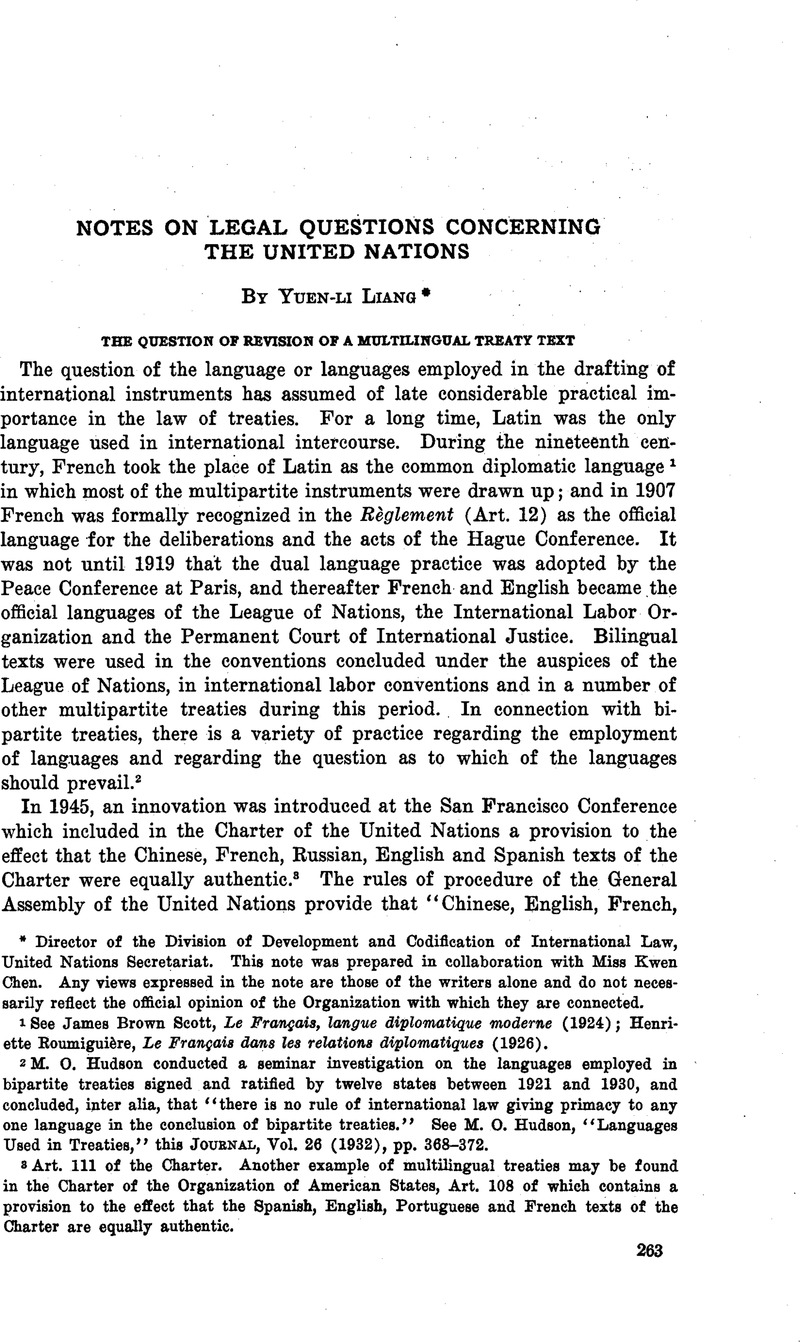Article contents
The Question of Revision of a Multilingual Treaty Text
Published online by Cambridge University Press: 20 April 2017
Abstract

- Type
- Notes on Legal Questions Concerning the United Nations
- Information
- Copyright
- Copyright © American Society of International Law 1953
References
1 See James Brown Scott, Le Français, langue diplomatique moderne (1924); Henriette Roumiguière, Le Français dans les relations diplomatiques (1926).
2 M. O. Hudson conducted a seminar investigation on the languages employed in bipartite treaties signed and ratified by twelve states between 1921 and 1930, and concluded, inter alia, that “there is no rule of international law giving primacy to any one language in the conclusion of bipartite treaties.” See M. O. Hudson, “Languages Used in Treaties,” this Journal, Vol. 26 (1932), pp. 368–372.
3 Art. 111 of the Charter. Another example of multilingual treaties may be found in the Charter of the Organization of American States, Art. 108 of which contains a provision to the effect that the Spanish, English, Portuguese and French texts of the Charter are equally authentic.
4 First sentence of Rule 51 of the Rules of Procedure of the General Assembly, U. N. Doc. A/520/Rev. 2, June 5, 1951, p. 10. The rules concerning languages were adopted by the General Assembly on Feb. 1, 1946, see U. N. Doc. A/64, p. 9.
5 First sentence of Eule 58, U. N. Doc. A/520/Rev. 2, p. 11.
6 General Assembly Resolution 22(I)A, Feb. 13, 1946, U. N. Doc. A/64; U. N. Treaty Series, Vol. I, No. 4 (1946–1947).
7 General Assembly Resolution 317(IV), March 21, 1950, U. N. Doc. A/1251, pp. 33–36.
8 Minutes of the 35th session of the Governing Body, May-June 1927, p. 366.
9 See League of Nations, International Labour Conference, 10th Sess., Vol. 1, Pts. 1-3, p. 551; Ernest Mahaim, “Les Conventions Internationales du Travail,” 11 Revue de droit international et de législation comparée (1930) 144.
10 U. N. Doc. A/C.6/SR.356, Dec. 22, 1952, pp. 10, 12.
11 Ibid., p. 12.
12 Pollux, “The Interpretation of the Charter of the United Nations,” 23 British Yearbook of International Law (1946) 79. Cf. statement of A. D. McNair: “It is always desirable, where more than one text is used, to state either which is authentic or that both are equally authentic. In the absence of provision to the contrary, neither text is superior to the other.” McNair, The Law of Treaties (1938), p. 59.
13 League of Nations, International Labour Conference, 10th Sess., Vol. 1, Pts. 1–3, p. 551.
14 U. N. Doc. A/C.6/SR.354, p. 6.
15 U. N. Doc. A/C.6/SR.355, p. 11.
16 General Assembly Resolution 260(III), U. N. Doc. A/810; this Journal, Supp., Vol. 45 (1951), p. 7.
17 U. N. Doc. A/1880, Sept. 18, 1951. The question was placed on the agenda of the sixth session of the General Assembly. The Assembly, by Resolution 605 (VI) adopted on Feb. 1, 1952, considered that the elements necessary for the discussion of the question were not yet at its disposal, and decided to postpone the discussion until the seventh session of the Assembly. See U. N. Doc. A/2119, p. 87.
18 U. N. Doc. A/2221, Oct. 14, 1952, p. 1.
19 Ibid., p. 2.
20 U. N. Doc. A/L.116, Nov. 28, 1952. After the General Assembly referred the question to the Sixth Committee for study and consideration, the same draft resolution was submitted by the Chinese Delegation to the Committee as Document A/C.6/L.283.
21 U. N. Doc. A/P.V.400, p. 36.
22 U. N. Doc. A/C.6/SR.354, p. 6.
23 Ibid., p. 11.
24 Ibid., p. 13.
25 U. N. Doc. A/C.6/L.283/Rev.1.
26 U. N. Doc. A/C.6/SR.356, p. 8.
27 U. N. Doc. A/P.V.411, p. 6.
28 U. N. Docs. A/C.6/SR.354, pp. 9, 13; A/C.6/SR. 355, pp. 3, 5–7; A/C.6/SR.356, p. 8.
29 U. N. Doc. A/C.6/L.283/Rev. 2; see also Report of the Sixth Committee, Doc. A/2351.
30 U. N. Doc. A/C.6/L. 289; General Assembly Resolution 691 (VII), U. N. Doc. A/2361, p. 64.
31 Yi-ting Chang, The Interpretation of Treaties by Judicial Tribunals (1933), p. 157. He adds: “In cases where evidence does not lead to definite conclusions as to which version expresses the actual agreement of the parties, tribunals generally go as far as possible to draw the sense from, and in harmony with, both versions. Nevertheless, tribunals do no hesitate to declare the one language used in the negotiations and drafts as ‘basic’ and as ‘un enseignement précieux sur les intentions des rédacteurs’ of the treaty when evidence shows that the other version, although declared equally authoritative in the treaty, is a mere translation.” Cases before international tribunals, including the Permanent Court of International Justice, involving questions arising out of differences in meaning between two authoritative language texts of a treaty are discussed in a chapter entitled “Version in Differing Languages,” op. cit., pp. 141–157, 184–185. Passages extracted from the decisions of the Permanent Court of International Justice concerning the interpretation of texts involving questions of languages used may be found in paragraphs 78, 79, 81, and 305 in Hambro, The Case Law of the International Court (1952). See also note on “Languages Used in Agreements between States,” Hudson, Cases on International Law (3rd ed., 1951), p. 449.
32 J. Morellet, “At What Moment do the International Labour Conventions become Applicable?”, International Labour Review, Vol. XVI, No. 6, December, 1947; also M. O. Hudson, International Legislation, Vol. I, 1919–1921, Introduction, sec. 34, p. lix.
- 2
- Cited by


